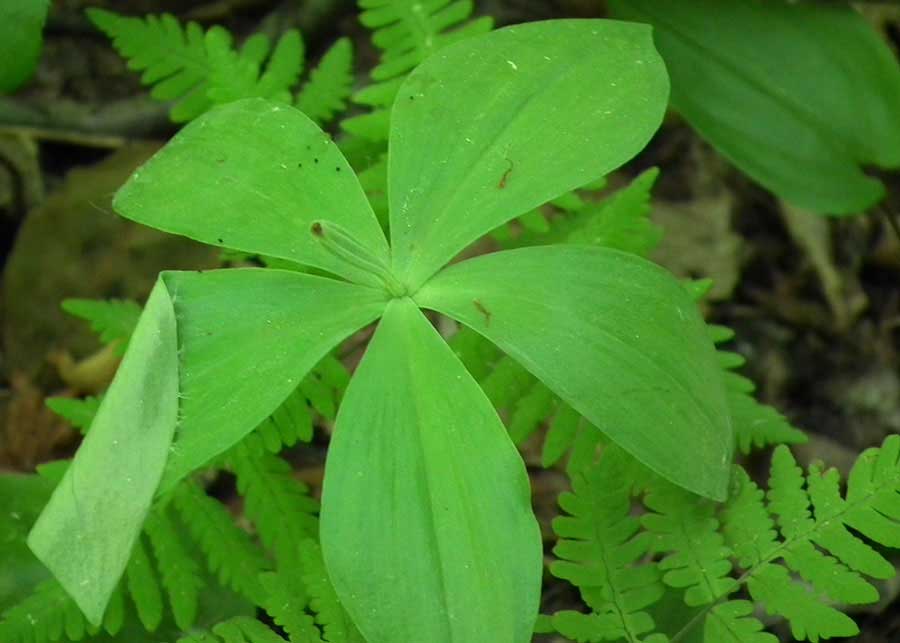Small Whorled Pogonia

Introduction
This chapter provides a review of progress toward protection and recovery of Small Whorled Pogonia in Ontario from 2007 to 2015.
Species information
Small Whorled Pogonia (Isotria medeoloides) is a small orchid that grows to between 9.5 and 25 centimetres in height. Small Whorled Pogonia has five to six leaves that form a whorl at the top of the stem. Between mid-May and mid-June the species produces one or two yellowish-green flowers over top of the leaves.
In Canada, Small Whorled Pogonia has been known to only exist in Elgin County in southwestern Ontario. Recently, a second population was discovered in Norfolk County. Small Whorled Pogonia inhabits damp, mixed forests with acidic soil and flat ground. The species requires a large amount of leaf mould and decaying vegetation, such as fallen tree limbs, minimal amounts of small vegetation, such as shrubs, and small openings in the tree canopy to provide light.
Small Whorled Pogonia faces several threats to its survival and recovery. Potential threats to Small Whorled Pogonia include trampling by humans and animals, lack of suitable habitat and collection of specimens. Because the species only exists in southern Ontario, which is highly urbanized, lack of suitable habitat for the species to spread is a significant threat to its survival and recovery. Herbivory by deer has not yet been recorded within the Canadian population of the species but may still pose a threat.
The survival and recovery of Small Whorled Pogonia are influenced by other factors as well. The Ontario population of Small Whorled Pogonia is very small. Small populations often lead to decreased genetic variation, which means a population is less able to adapt to change, thereby limiting its ability to survive and recover. Small Whorled Pogonia is sensitive to habitat disturbance, has low reproductive rates, and goes through long periods where the plant is dormant as a means to conserve resources until it is no longer stressed. Each of these characteristics limits the ability of Small Whorled Pogonia to survive and recover.
Small Whorled Pogonia is listed as endangered at both the provincial (Species at Risk in Ontario List) and federal (Schedule 1 under the Species at Risk Act) levels. Globally, it is considered to be imperiled.
Provincial status
The Small Whorled Pogonia was regulated under the previous Endangered Species Act and has been listed as endangered since 1981. Under the Endangered Species Act, 2007 (ESA or “the Act”) Small Whorled Pogonia retained its status as endangered. In future assessments, COSSARO may consider information gained through protection and recovery actions regarding the species’ threats and trends in population and distribution.
Species and habitat protection
Protecting Small Whorled Pogonia and its habitat are key components in the implementation of the ESA, and continue to be government-led actions, as identified in the government response statement. As a species that was regulated under the previous Endangered Species Act, Small Whorled Pogonia has received species and habitat protection since 1981. Small Whorled Pogonia retained these protections under the ESA, which prohibits the species from being killed, harmed, harassed, captured or taken and protects its habitat from being damaged or destroyed. Habitat protection for the species is based on the general habitat definition in the Act, as the ESA does not require a habitat regulation to be developed for transition species
As a species that was regulated under the previous Endangered Species Act, Small Whorled Pogonia has received species and habitat protection since 1981. The species is currently protected from being killed, harmed, harassed, captured or taken under the ESA.
In addition, the habitat of Small Whorled Pogonia is currently protected from being damaged or destroyed based on the general habitat definition in the ESA.
Recovery strategy
A recovery strategy for Small Whorled Pogonia was published on February 18, 2011, which was in advance of the date required by the ESA. Recovery strategies are advice to government and represent the best available scientific knowledge. The strategy identifies Small Whorled Pogonia habitat needs and the threats that it faces, while recommending objectives and approaches for protecting and recovering the species. The recovery strategy also includes recommendations on the areas of habitat to be considered in the development of a habitat regulation.
Government response statement
The Ministry of Natural Resources and Forestry (“the Ministry”) published the government response statement (GRS) for Small Whorled Pogonia on November 18, 2011, which was within the timeframe required by the ESA. The GRS is government policy that contains the Government of Ontario’s goal for the recovery of Small Whorled Pogonia.
Recovery Goal
The government’s goal for the recovery of Small Whorled Pogonia is to maintain the persistence of Ontario’s only population.To help achieve this goal, the government leads and supports recovery actions identified in the GRS. Common actions for the government to lead as it works toward achieving a species’ recovery goal are provided in section 2.5 of the Species at Risk Program Status (2008–2015). The GRS for Small Whorled Pogonia also outlines three actions for which the Ministry is using a variety of methods to support others to undertake. These government-supported actions fall under the objectives identified in the GRS, which are:
- Confirm existence of Small Whorled Pogonia in the Calton Swamp area and determine its extent and abundance;
- Increase available habitat for Small Whorled Pogonia; and
- Increase awareness to promote the protection of Small Whorled Pogonia.
under the previous Endangered Species Act in 1981 and then through the general habitat definition under the current ESA since 2008
Supporting our partners
Supporting partners through the Species at Risk Stewardship Fund, as well as through permits and their associated conditions, is an important government-led action. To date, no authorizations or regulatory provisions have been issued or registered for the species.
Through the Species at Risk Stewardship Fund, the Ministry has supported a total of nine projects ($158,742) designed to contribute to the protection and recovery of Small Whorled Pogonia. One project ($19,000) focused exclusively on Small Whorled Pogonia, while the other eight projects ($139,742), one of which was over multiple years, focused on multiple species at risk, including Small Whorled Pogonia. In addition to the funding provided through the Species at Risk Stewardship Fund, the partner that focused exclusively on Small Whorled Pogonia reported that they were successful in securing additional funding ($45,625) from other sources, as did partners with projects designed to benefit multiple species at risk, including Small Whorled Pogonia ($578,252). These amounts include additional funding and in-kind support in the form of time and expertise provided by volunteers.
Stewardship partners reported that provincial funding helped them to secure in-kind support by involving a total of 911 individuals who volunteered 11,188 hours of their time toward protection and recovery activities for multiple species at risk, including Small Whorled Pogonia, which has an estimated value of $217,540.
Stewardship partners reported that through both their efforts and the efforts of their volunteers to implement actions contained in the GRS, they were successful in enhancing our knowledge about the habitat needs of this orchid species. In addition, stewardship partners reported delivering ecosystem-based outreach on multiple species at risk to 6,772 individuals.
The remainder of this section highlights one project conducted by partners that were supported through the Species at Risk Stewardship Fund and their corresponding government-supported recovery actions.
The stewardship partner established two permanent 10 m x 10 m plots in an area where Small Whorled Pogonia stems were previously documented. Thorough site analyses at the plots were undertaken, including plant species composition, percent canopy cover, tree basal area assessments, and mapping of coarse woody debris to help inform future management and protection of 20 hectares of habitat for Small Whorled Pogonia in this area. The results of the site analyses indicate that conditions are suitable for the species to grow and thrive.
Although plants were not found during the surveys, this does not mean it is no longer present, as this orchid can remain dormant underground for long periods of time. Based on the overall project results, further investigations are encouraged to increase knowledge of the species’ presence and habitat preferences. This project supports the GRS actions to conduct surveys in Calton Swamp to confirm the remaining populations of Small Whorled Pogonia (a high priority in the GRS) and to increase habitat associated with the one known existing Ontario population of Small Whorled Pogonia.
Species at Risk Stewardship Fund
-
 $19,000
$19,000For Small Whorled Pogonia exclusively
-
 $139,742
$139,742For multi-species projects that included Small Whorled Pogonia
-
 $623,877
$623,877In additional funding and support
-
 9 projects
9 projectsIncluded the Small Whorled Pogonia
-
 911
911Volunteers
-
 11,188
11,188Volunteer hours
-
 20
20Hectares
-
 6,772 people
6,772 peopleReceived outreach
Occurrences of Small Whorled Pogonia in Ontario
Natural Heritage Information Centre (NHIC)
Small Whorled Pogonia has been documented intermittently in the Calton Swamp area of southwestern Ontario in the years between 1976 and 1998. This population
Since 2008, when Small Whorled Pogonia became protected under the ESA, the Ministry has received approximately 13 records of the species. These records are based on observations between 1976 and 2014 and come from a variety of sources. Records submitted have helped to redefine where the species is known and has been known to occur and have provided additional information on the species’ habitat and threats. It is possible that there are observations of Small Whorled Pogonia that have not been submitted to the Ministry. Encouraging the submission of observations of Small Whorled Pogonia to the Ministry is included in the GRS as a government-led action.
Everyone is encouraged, or may be required by an authorization or approval, to submit observations of the Small Whorled Pogonia, as well as every other species at risk, to the Ministry’s Natural Heritage Information Centre for incorporation into the provincial record of observations.
13 Observations of this species were submitted to the NHIC since 2008
Summary of progress toward meeting the recovery goal
Summary of progress
Progress has been made toward all government-led actions and all government-supported actions outlined in the GRS for Small Whorled Pogonia. The Government of Ontario has directly undertaken actions to:
- Encourage submission of Small Whorled Pogonia data to the Natural Heritage Information Centre;
- Protect the species and its habitat through the ESA;
- Support partners to undertake activities to protect and recover the species;
- Establish and communicate annual priority actions for support;
- Educate other agencies and planning authorities on the requirement to consider the protection of the species and its habitat; and
- Undertake communications and outreach to increase public awareness of species at risk in Ontario.
Government-supported actions are organized under over-arching recovery objectives. Progress has been made toward all of the government-supported recovery objectives and several of the associated actions that are identified in the GRS for Small Whorled Pogonia.
Under the objective to confirm existence of Small Whorled Pogonia in the Calton Swamp area and determine its extent and abundance, progress has been made toward the action:
- Conduct surveys in the Calton Swamp to confirm the presence of Small Whorled Pogonia and if found, document information about each occurrence and monitor the plants. (Action No. 1; High Priority).
A stewardship partner established permanent study plots in Calton Swamp and conducted surveys to confirm the one known existing Ontario population of Small Whorled Pogonia.
Under the objective to increase available habitat for Small Whorled Pogonia, progress has been made toward the action:
- Identify and implement strategies to increase habitat in the areas surrounding the known population. (Action No. 2).
Analyses conducted during the study noted above, including ecological land classification and plant inventories, indicate that conditions are suitable for this species to grow and thrive and will help inform enhanced protection and management of orchid habitat in Calton Swamp.
Under the objective to increase awareness to promote the protection of Small Whorled Pogonia, initial progress has been made toward the action:
- Provide information and education to orchid enthusiasts and others regarding the risk to Small Whorled Pogonia from inadvertent trampling. (Action No. 3).
Collectively, these actions have been implemented through projects supported by the Species at Risk Stewardship Fund and through independent efforts by government partners.
The recovery goal for Small Whorled Pogonia is to maintain the persistence of Ontario’s only population. Effort made toward the government-led and government-supported GRS actions has helped to make progress toward this goal.
Confirming the presence of this species is challenging as it can remain dormant underground with no visible trace for long periods of time. Although Small Whorled Pogonia was not identified during surveys recently completed in Calton Swamp, it is strongly suspected that the species will continue to persist in Ontario due to the presence of suitable habitat in the areas where the species has been documented, and the discovery of a new population in an adjoining county. This is consistent with the recovery goal for Small Whorled Pogonia, and actually exceeds the goal of maintaining a single population.
Recommendations
As stated in the GRS, the review of progress toward protecting and recovering Small Whorled Pogonia can be used to help identify whether adjustments are needed to achieve the protection and recovery of the species. The GRS actions completed to-date for Small Whorled Pogonia have enhanced knowledge about identification and management of habitat for the species, and identified the need to continue surveying for plants in the Calton Swamp. With the discovery of a new population of this orchid in Norfolk County (the second ever in Ontario and all of Canada), it is recommended that the GRS intent be applied to all populations of the species.
Relative to actions that have received a higher level of support, the following action has received support to a lesser degree and may be considered in future decisions regarding the protection and recovery of Small Whorled Pogonia:
- Provide additional information and education to orchid enthusiasts and others regarding the risk to Small Whorled Pogonia from inadvertent trampling due to the new population in Ontario.
Moving forward, protecting and recovering Small Whorled Pogonia will continue to be a shared responsibility that will require the involvement of many individuals, organizations and communities. Financial support for the implementation of actions may be available through the Species at Risk Stewardship Fund or the Species at Risk Research Fund for Ontario. The Ministry can also advise if any authorizations under the ESA or other legislation may be required to undertake a project. By working together, progress can continue to be made toward protecting and recovering Small Whorled Pogonia in Ontario.
Summary of progress toward the protection and recovery of Small Whorled Pogonia (2007 to 2015)
Provincial status:
- Small Whorled Pogonia is classified as endangered under the Endangered Species Act, 2007 (ESA). Small Whorled Pogonia was also listed under the previous Endangered Species Act, and has retained the same status since transition to the ESA. Small Whorled Pogonia has received species and habitat protection under the ESA since 2008.
Species-specific documents and guidance published by the government:
- Recovery Strategy for Small Whorled Pogonia (Isotria medeoloides) in Ontario (2011)
- Small Whorled Pogonia: Ontario Government Response Statement (2011)
Government-supported stewardship projects:
- Through the Species at Risk Stewardship Fund the Ministry of Natural Resources and Forestry (“the Ministry”) has enabled its stewardship partners to conduct a total of nine projects that have supported the protection and recovery of Small Whorled Pogonia. One project ($19,000) focused exclusively on Small Whorled Pogonia, while the other eight projects ($139,742) focused on multiple species at risk, including Small Whorled Pogonia.
- The Ministry’s support helped its stewardship partners to involve 911 individuals who volunteered 11,188 hours of their time toward protection and recovery activities for species at risk, including Small Whorled Pogonia. The estimated value of these voluntary contributions, as well as additional funding and in-kind support, is $623,877 over five years.
- Stewardship partners reported that, through their actions, management and protection of 20 hectares of habitat for the persistence of Small Whorled Pogonia in Ontario has been enhanced through site analyses conducted in Calton Swamp.
- Stewardship partners reported providing outreach on multiple species at risk, including Small Whorled Pogonia to 6,772 individuals.
Occurrences and distribution:
- There are two populations of Small Whorled Pogonia in Ontario. In 2008, one population was known to occur in southwestern Ontario in the Calton Swamp area. Currently, this population is considered extant. In 2014, a new population was discovered in an adjoining county.
- Since 2008 the Ministry has received 13 records of the species, including the newly-identified population in southwestern Ontario.
Related Information
- Categorizing and Protecting Habitat under the Endangered Species Act
- Natural Heritage Information Centre
- Ontario’s Endangered Species Act
- Ontario’s Endangered Species Act Regulation 242/08
- Ontario Recovery Strategy and Government Response Statement for Small Whorled Pogonia
- Policy Guidance on Harm and Harass under the Endangered Species Act
- Species at Risk in Ontario List
- Species at Risk Stewardship Fund
References
COSEWIC. 2001. COSEWIC status appraisal summary on the Small Whorled Pogonia Isotria medeoloides in Canada. Committee on the Status of Endangered Wildlife in Canada. Ottawa. xi pp.
Kraus, T. 2011. Recovery Strategy for the Small Whorled Pogonia (Isotria medeoloides) in Ontario. Ontario Recovery Strategy Series. Prepared for the Ontario Ministry of Natural Resources, Peterborough, Ontario. ii + 6 pp. + Appendix iv + 13 pp. + Addenda.
Footnotes
- footnote[1] Back to paragraph A "transition species" is a species listed under schedule 1, 3, or 4 of the ESA that has not changed in status since June 2008.